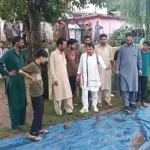New Delhi, April 09: A fascinating photo exhibition showcasing the rich cultural and technological legacy of ‘Ambaran’, a historic Buddhist site in Jammu and Kashmir, has opened to the public at the National Museum in New Delhi. The exhibition offers an extraordinary visual journey into life as it existed over 2,000 years ago.
Titled “Ambaran”—the ‘Historic Citadel of Buddhism in Jammu and Kashmir’, the exhibition has been curated by veteran journalist-photographer Vijay Kranti. It was inaugurated on April 2 by J&K’s Sports Minister Satish Sharma and Meenakshi Lekhi, former Minister of State for External Affairs and Culture. The exhibition will remain on display until May 9.
Jointly organised by the National Museum and the Centre for Himalayan Asia Studies and Engagement (CHASE), the exhibition features rare photographs of artefacts excavated during 1999–2000 by a team from the Archaeological Survey of India (ASI), led by noted archaeologist Dr B.R. Mani. The exhibits provide insight into the high level of craftsmanship, architecture, metallurgy, and personal aesthetics of the time. Among the most striking discoveries are pearls with minute drilled holes, uniform terracotta bricks used in stupas and meditation halls, and intricate jewellery and hairstyles depicted on terracotta figurines—revealing refined tastes and advanced technical skills.
The site of Ambaran is believed to have functioned as a major Buddhist monastic complex between the 2nd century BCE and 7th century CE—centuries before Buddhism spread to Ladakh and Tibet. The discovery of Kushan and Hun era coins further reinforces the site’s historical importance.
Vijay Kranti, widely recognised for his decades-long documentation of Tibetan culture, is now focused on highlighting lesser-known yet culturally rich sites in Jammu and Kashmir through photography. Minister Satish Sharma noted that while the exhibition is in Delhi, it underscores the potential of Ambaran as a heritage and spiritual tourism destination, due to its proximity to other historic landmarks in the Jammu region. The exhibition is open to the public at the National Museum until May 9 and is expected to travel to Jammu and Srinagar later this year.








